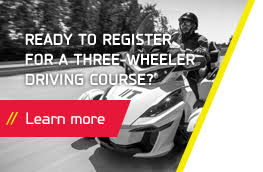Phase 1: Prerequisite to learner's licence
Phase 1 is the prerequisite phase that precedes the actual driving.

During this phase, the learner will participate in 5 theoretical 2-hour modules. The topics covered will include:
- the car;
- the driver;
- the environment;
- risky behaviours;
- the summary and driving school evaluation.
He should be an active co-pilot!
Your role begins at this very moment, and complements these various elements that the learner will be taught. When you are in a vehicle with the learner, make sure he acts as an active co-pilot.
Even if the learner is not behind the wheel, ask him questions regarding:
- the vehicle’s various functions and controls;
- what he learned during his last few courses or what he’s discovered that surprised him;
- what he feels are sources of danger (children playing, pedestrians, cyclists, animals, people on their cellular phone, etc.);
- which vehicle proceeds first at an intersection;
- the meaning of various road signs;
- sources of danger that must be identified.
For this type of exercise, both the learner and you must be in good physical condition and mentally alert. To avoid wearing yourselves out, it is recommended that you do these types of exercises for short periods at a time (maximum of 10-15 minutes).
Checklist – Important points

- Insurance
The minute the learner gets behind the wheel of your vehicle, you must make sure he is covered by your insurance policy. Call your insurance company and ask them to add him to your policy as an occasional driver. And of course, don’t hesitate to ask them any questions you may have!
- Driver’s licence
During practice sessions with your learner, you must always have your driver’s licence with you even if you are not driving.
- Mirror with suction cup for accompanying rider
 Did you know that you can buy a small mirror equipped with a suction cup in most large retail stores? Many accompanying riders find this to be an excellent safety tool.
Did you know that you can buy a small mirror equipped with a suction cup in most large retail stores? Many accompanying riders find this to be an excellent safety tool.
- Zero tolerance
Drivers with a learner’s licence are subject to a zero tolerance rule with regard to alcohol consumption.
- Learner’s licence = 4 demerit points
When the holder of a learner’s licence accumulates more than 3 demerit points, the SAAQ will send him a written notice that his learner’s licence has been revoked. (In other words, his licence is cancelled and he is no longer entitled to drive a vehicle.) The learner will not be able to obtain a new learner’s licence for at least 3 months after such a revocation.
- Adjustments prior to hitting the road (mirrors, seat belt, etc.)
When a learner gets behind the wheel of a vehicle, the first thing he should do is buckle up. This should be followed by a check of the mirrors, seat position, etc.
- Obligations of learner's licence holders:
-
- Be accompanied at all times by an accompanying rider who has held a valid Class 5 driver’s licence for at least 2 years and who is capable of providing help and advice;
- Not accumulate more than 4 demerit points on their driving record; otherwise, their licence will be revoked and they will be unable to obtain a new one for at least three months;
- Not drive between midnight and 5 a.m.;
- Not drive after consuming alcohol.
Fostering good habits.

Updating your knowledge of driving rules
It’s important to remember that obtaining a driver’s licence takes a bit more time today than it used to. Because a few steps have been added to the former process, you may need to familiarize yourself with current requirements to best help your future driver.
Fitting the driving course into his current schedule
Your learner will need to dedicate time and effort to obtaining his driver’s licence. This will require him to add the 39 hours of his driving school program into his schedule, all while making sure he doesn’t neglect his school work, exams, personal activities, etc.
To become a safe and responsible driver, he will need to supplement his driving school courses with additional practice sessions. You were selected as the accompanying rider! Keep in mind that it is important for your learner to practice with his accompanying rider at least 50 hours during his whole training program. That’s on top of the in-car sessions included in the training program. This will require that you set aside periods of time to practice with your learner.
Below are two tips to simplify matters and make practices easier to organize:
- Plan shorter rather than longer practice sessions (15 to 30 minutes).
- Let your learner take the wheel whenever possible; every opportunity he has to drive with you will make him a better driver!
Planning practice sessions ahead of time and entering them in both of your calendars or planners
Get together to plan practice sessions ahead of time, making sure to enter them in both of your calendars or planners. For example, you could have the learner get behind the wheel when you go grocery shopping every week, when he goes to sports practice, when you head off to the cottage for the weekend, on the way to the driving course, when the learner goes to see his friends, etc.
Here’s an example of a week of practice sessions that provide the learner with a total of 60 minutes behind the wheel, broken down into 5 separate outings:
| Sunday | Monday | Tuesday | Wednesday | Thursday | Friday | Saturday | Total |
|
10 minutes Arena |
15 minutes Grocery store |
5 minutes School |
15 minutes Friends |
15 minutes Tecnic |
60 minutes of pratice |
| Sunday |
10 minutes Arena |
| Monday | |
| Tuesday |
15 minutes Grocery store |
| Wednesday |
5 minutes School |
| Thursday | |
| Friday |
15 minutes Friends |
| Saturday |
15 minutes Tecnic |
| Total |
60 minutes of pratice |
Getting prepared for Phase 2.
Being a good - model! - driver
Your learner has likely been watching you drive for years. You will now need to be even more mindful of your attitude while at the wheel. Are you calm or more likely to react? This is truly the time to set an example. Remember, your goal is to help the learner become a responsible and safe driver, in other words, someone you wouldn’t mind sharing the road with.
Bringing up the topic of safety
Getting a driver’s licence is a big step in becoming more independent. Of course, for you, it likely also constitutes a source of stress: texting, driving impaired, speeding... It’s normal to worry, but also important to discuss these types of issues with your learner as soon as possible. Doing so will bring you closer and help reinforce the trust you have in each other. So, where do you start? Begin by drawing up a contract! This document could include elements such as: being a courteous driver, never drinking and driving, never using a cellular phone while driving, etc. Both parties should sign the contract to make it official. This agreement will make it possible for you to set guidelines and refer to them as needed.
Supervising the practice sessions - To read before each phase / Advice for each phase
Bear in mind that aside from the important role played by the driving school, YOU are the guide who will spearhead the learner’s driving education! Give due consideration to the pace at which he’s assimilating the material and suggest that you hold practice sessions in scenarios where you are both at ease. For example, you could make your way to a parking lot to test out certain basic maneuvers. This is a good way for both of you to build confidence. Over time, gradually modify the scenarios, driving in various weather conditions and on different types of roads.
We’ve created the following documents in the Toolbox with regard to the four phases: Advice - Phase 1, Advice - Phase 2, Advice - Phase 3 and Advice - Phase 4. We recommend that you read over these respective documents prior to beginning a new phase and heading out for practice sessions. They’ll provide you with a lot of ideas and safety tips to implement with your learner.
Setting safety rules for unexpected situations
It’s highly recommended to establish a list of simple rules that your learner must follow, particularly in unexpected situations. For example: What should he do if he loses control? Make his way to the shoulder (of the road)? Slow down? Setting certain ground rules will help the learner both prevent and better manage unexpected situations. When it's time to start Phase 2 practice sessions with your learner, we suggest that you to read the article: Driving Safety Tips. It will give you tips and advice that can be useful for your practice sessions.
Communicating with your learner in a clear and calm manner
Communication is critical to successful practice sessions. Stay calm when intervening with the learner. Always strive to give clear explanations and specific examples. Some of the things that appear “natural” to you may still be uncharted territory for your learner! Certain reflexes, such as putting on a turn signal, looking around before changing lanes and checking out blind spots, are things that learners need to develop over time. It will greatly help your learner if you remember this.
Developing good “accompanying rider” reflexes
Accompanying riders need to react very quickly when necessary. You also need to pay as much attention to the road as you do when you’re behind the wheel. To ensure you’re well-prepared, this will be explained to you in further detail by a Tecnic instructor during the Module 6 classroom session that you will be invited to attend with your learner. We also suggest that you read the document entitled Safety tips for driving, which is included in the Toolbox (Phase 2).
Staying calm at all times
Regardless of the circumstances, take a deep breath and... stay calm! This tip applies to both you and your learner. Familiarizing oneself with the ins and outs of driving can be very stressful. To start things off on the right foot, both you and your learner should be open about any aspects of the process that you find worrisome. After this, trust your learner, no matter how difficult it may be initially. His driving courses have provided him with a very good foundation; give him a chance to become more confident with time... and practice!
Doing your best
Thus far, you have no doubt done your best to teach your learner important facts of life. A similar approach should prove very useful while he’s learning to drive. Don’t forget – you’re giving your learner his independence, as he is just about to obtain his driver’s licence. That’s great - keep it up! We’re confident that your learner will receive all of the support he needs. You can count on us to teach him the fundamentals of driving and in so doing, support you in your role as an accompanying rider!
A few reminders
Seatbelts and airbags
In the event of an accident, the combination of seatbelts and airbags reduces by 75% the risk of suffering serious head injuries. It’s extremely important for drivers to properly buckle up and adjust their seat (including the back).
What to do when there are no speed limit signs in sight?
If there are no visible speed limit signs, drivers should not exceed 50 km/h.
Driving in a school zone
According to the Highway Safety Code, the speed limit in a school zone is 50 km/h whenever children are arriving at or leaving the school. Many municipalities, however, have lowered this limit to 30 km/h. Therefore unless you know the speed limit, we recommend that you do not exceed 30 km/h in a school zone. Stay alert!
Learners can also receive a ticket
The police can - just like they do with other drivers - stop a learner and issue a ticket (including demerit points) when applicable.
Risk factors while at the wheel
Several factors can increase the risk a driver faces whenever he gets behind the wheel. They include things such as time of day and day of the week, fatigue, receiving bad news, etc. All these can become problematic when combined with a lack of experience. Stay alert and keep an eye on your learner!
For more information on your role as an accompanying rider, take a look at the following document prepared by the SAAQ:
P.-S.: Remember to reserve a spot with the driving school so that you can take part in module 6 (theoretical, Accompanied Driving), which is held during phase 2 of the program. This module will provide you with information that you can use in your role as an accompanying rider.




